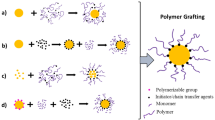Abstract
Particle hydrogel composite (PHC) combines the characteristics of at least two materials and has potential applications in many fields. Different functions require the particle size to range from nanometer to millimeter, which has a noticeable effect on the mechanical properties of the hydrogel composites. In this paper, the mechanical properties of silica-inlaid PAAM hydrogel are measured with various particle diameters from 75 nm to \(50\, \upmu \hbox {m}\). Experimental results show no obvious size effect on the mechanical properties of PHC when the particle diameter falls in micron scale. However, as the particle size decreases to nanoscale, the modulus of the PHC begins to increase rapidly. The size-irrelevant moduli and stress fields of PHCs with random and uniform particle distributions under different loading conditions are obtained based on the finite element method. Meanwhile, the toughening mechanism and the failure of the PHC are investigated. The size-irrelevant modulus of the PHC is also predicted by the equivalent inclusion theory. Finally, the interaction between the hydrogel polymer chains and the particles is described from the microscopic point of view, requiring the nanoscale size-dependent theory and new experimental approach to further explore the mechanical properties of PHC.




Similar content being viewed by others
References
Thoniyot P, Tan MJ, Karim AA, et al. Nanoparticle-hydrogel composites: concept, design, and applications of these promising, multi-functional materials. Adv Sci. 2015;2(1–2):1400010.
Klein A, Whitten PG, Resch K, et al. Nanocomposite hydrogels: fracture toughness and energy dissipation mechanisms. J Polym Sci Part B Polym Phys. 2015;53(24):1763–73.
Sun J, Zhao X, Illeperuma WRK, et al. Highly stretchable and tough hydrogels. Nature. 2012;489(7414):133–6.
Guo J, Liu X, Jiang N, et al. Highly stretchable, strain sensing hydrogel optical fibers. Adv Mater. 2016;28(46):10244–9.
Lin S, Yuk H, Zhang T, et al. Stretchable hydrogel electronics and devices. Adv Mater. 2016;28(22):4497–505.
Yang CH, Chen B, Lu JJ, et al. Ionic cable. Extreme Mech. Lett. 2015;3:59–65.
Pathak AK, Singh VK. A wide range and highly sensitive optical fiber pH sensor using polyacrylamide hydrogel. Opt Fiber Technol. 2017;39:43–8.
Ionov L. Biomimetic hydrogel-based actuating systems. Adv Funct Mater. 2013;23(36):4555–70.
Tavakoli J, Tang Y. Hydrogel based sensors for biomedical applications: an updated review. Polymers. 2017;9(12):364.
Culver HR, Clegg JR, Peppas NA. Analyte-responsive hydrogels: intelligent materials for biosensing and drug delivery. Acc Chem Res. 2017;50(2):170–8.
Tang J, Tong Z, Xia Y, et al. Super tough magnetic hydrogels for remotely triggered shape morphing. J Mater Chem B. 2018;6:18.
Chin SY, Poh YC, Kohler AC, et al. Additive manufacturing of hydrogel-based materials for next-generation implantable medical devices. Sci Robot. 2017;2:6451.
Sun Y, Wang Y, Yao J, et al. Highly magnetic sensitivity of polymer nanocomposite hydrogels based on magnetic nanoparticles. Compos Sci Technol. 2017;141:40–7.
Dionigi C, Piñeiro Y, Riminucci A, et al. Regulating the thermal response of PNIPAM hydrogels by controlling the adsorption of magnetite nanoparticles. Appl Phys A. 2014;114(2):585–90.
Cai Z, Kwak DH, Punihaole D, et al. A photonic crystal protein hydrogel sensor for Candida Albicans. Angew Chem Int Ed. 2015;54(44):13036–40.
Yang CH, Zhou S, Shian S, et al. Organic liquid-crystal devices based on ionic conductors. Mater Horiz. 2017;4(6):1102–9.
Sershen SR, Westcott SL, Halas NJ, et al. Independent optically addressable nanoparticle-polymer optomechanical composites. Appl Phys Lett. 2002;80(24):4609–11.
Eshelby JD. The determination of the elastic field of an ellipsoidal inclusion, and related problems. Proc R Soc Lond. 1957;241:376–96.
Mori T, Tanaka K. Average stress in matrix and average elastic energy of materials with misfitting inclusions. Acta Metall. 1973;21(5):571–4.
Wang QM, Gao ZM. A constitutive model of nanocomposite hydrogels with nanoparticle crosslinkers. J Mech Phys Solids. 2016;94:127–47.
Cho J, Joshi MS, Sun CT. Effect of inclusion size on mechanical properties of polymeric composites with micro and nano particles. Compos Sci Technol. 2006;66(13):1941–52.
Moloney AC, Kausch HH, Kaiser T, et al. Parameters determining the strength and toughness of particulate filled epoxide resins. J Mater Sci. 1987;22(2):381–93.
Xia Z, Zhou C, Yong Q, et al. On selection of repeated unit cell model and application of unified periodic boundary conditions in micro-mechanical analysis of composites. Int J Solids Struct. 2006;43(2):266–78.
Xia Z, Zhang Y, Ellyin F. A unified periodical boundary conditions for representative volume elements of composites and applications. Int J Solids Struct. 2003;40(8):1907–21.
Nian G, Shan Y, Xu Q, et al. Effects of hollow particle shape and distribution on the elastic properties of syntactic foams: 3D computational modeling. Comput Mater Sci. 2014;95:106–12.
Jordan J, Jacob KI, Tannenbaum R, et al. Experimental trends in polymer nanocomposites—a review. Mater Sci Eng A. 2005;393(1–2):1–11.
Rose S, Prevoteau A, Elzière P, et al. Nanoparticle solutions as adhesives for gels and biological tissues. Nature. 2014;505(7483):382–5.
Netz RR, Andelman D. Neutral and charged polymers at interfaces. Phys Rep. 2003;380(1–2):1–95.
Haider H, Yang CH, Zheng WJ, et al. Exceptionally tough and notch-insensitive magnetic hydrogels. Soft Matter. 2015;11(42):8253–61.
Tang J, Xu G, Sun Y, et al. Dissipative properties and chain evolution of highly strained nanocomposite hydrogel. J Appl Phys. 2014;116(24):244901.
Rubinstein M, Colby RH. Polymer-physics. Oxford: Oxford University Press; 2003.
Shen GL, Hu GK. Mechanics of composite materials. 1st ed. Beijing: Tsinghua University Press; 2010.
Xiang Y, Zhong D, Wang P, et al. A general constitutive model of soft elastomers. J Mech Phys Solids. 2018;117:110–22.
Acknowledgements
This work is supported by the Fundamental Research Funds for the Central Universities.
Author information
Authors and Affiliations
Corresponding author
Rights and permissions
About this article
Cite this article
Hu, X., Qu, S. Inclusion Size Effect on Mechanical Properties of Particle Hydrogel Composite. Acta Mech. Solida Sin. 32, 643–651 (2019). https://doi.org/10.1007/s10338-019-00093-8
Received:
Revised:
Accepted:
Published:
Issue Date:
DOI: https://doi.org/10.1007/s10338-019-00093-8




